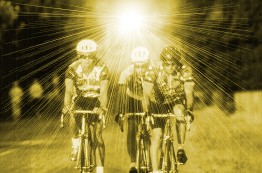
All About Eyewear For Cycling
Cycling eyewear is about a lot more than fashion! Good glasses protect your peepers, improve your vision, reduce fatique and help shield your face from the sun. Here's how to pick a pair:
Why Wear Sunglasses?
Sight is an amazingly complicated sense. Your eyes continually move and adjust, receiving a constant flow of information. Normally, all this activity happens routinely and without noticeable strain. When cycling, however, you are affected by glare and the sun’s ultraviolet radiation. Glare is annoying and discomforting causing your eyes to work harder, contracting your pupils, narrowing your eyelids and causing muscle fatigue. It also reflects off roads, traffic, water, snow, concrete and the glass in buildings.
Ultraviolet radiation (UV) is the invisible part of the light made up of UVA, UVB and UVC rays. Studies have shown that prolonged exposure to UV rays can cause many eye problems, such as cataracts, sunburn to the eyelids, macular degeneration, even skin cancer around the eyes. It's also one of the leading causes of vision loss among older Americans.
This is why quality eyewear is such an important cycling accessory. Good glasses help us see comfortably and clearly in sunlight, they counteract the discomfort caused by glare, and reduce the threat of permanent damage that could lead to cataracts and other eye diseases. The best cycling glasses reduce glare, filter out 99 to 100% of UV rays, provide visual protection, are comfortable and lightweight, stay in place on the face and do not distort colors.
Tips on Selecting Cycling Eyewear
Frames
We recommend wrap-style frames to protect your eyes from wind and debris. These offer more coverage and tend to stay in place better. To help control against fogging, look for air holes or vents in the frame or lens. If you ride in severe conditions, such as racing downhill, you may want to consider a goggle style.
Lenses
Look for lenses that offer 100% UV protection. Today's lenses are usually made of polycarbonate, a tough plastic with excellent impact resistance for durability and to protect your eyes from airborne debris. Because glare reflecting off the road can be an issue, you may want to consider glasses with polarized lenses, which absorb 98% of glare to improve vision and also allow seeing objects in their true colors.
The lens color affects how you see also. That's why some models come with one or more different color lens so you can swap to fine-tune your glasses to the conditions. It's also possible with most eyewear to replace the lens with a different color. Here's a rundown of what the different colors are best for.
Choosing a Lens Color
Brown and amber: These are the best lens colors for high glare. They allow excellent contrast and their dark color minimizes eye strain. They're effective for absorbing most blue light waves, which sharpens visual acuity, improving depth perception and contrast in variable light conditions. Amber is popular for cycling, skiing and general use. On the down side, amber distorts colors, making greens greener and causing neons to fade.
Gray: This is a neutral color that provides natural contrast and gives true color perception. It's a good, general-purpose color.
Green: A good all-purpose lens color, green provides a fair amount of contrast in low-light conditions and reduces eye strain in bright conditions.
Yellow: A long-time standard for skiing, yellow provides excellent depth perception and contrast in low light.
Other Considerations
Like regular sunglasses, you'll find cycling eyewear in a wide range of styles and prices. There are even models that accommodate prescription lenses. When shopping, keep in mind that a quality pair of cycling glasses can last for many years. So, come on in and let us help you select a pair that's right for you and your eyes. You'll be glad you did!
